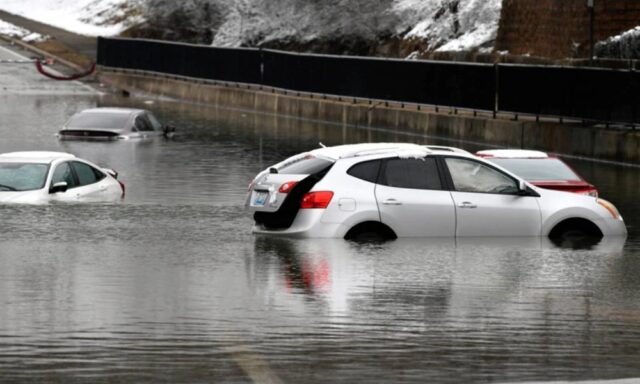WASHINGTON: At least nine people have died after heavy rains submerged roads and homes in the southeastern US.
Kentucky Governor Andy Beshear confirmed eight deaths and warned the toll could rise as search efforts continue.
Rescue teams saved hundreds stranded in floodwaters, with many trapped inside their vehicles.
Beshear urged residents to stay indoors and avoid dangerous road conditions to prevent further casualties.
In Georgia, a man died when an uprooted tree crashed into his home while he was asleep.
Widespread Damage Across Eight States
Storm alerts were issued for Kentucky, Georgia, Alabama, Mississippi, Tennessee, Virginia, West Virginia, and North Carolina.
These states were already recovering from September’s Hurricane Helene, which caused severe destruction.
More than half a million households across the region lost power by Sunday night, according to poweroutage.us.
Kentucky saw the worst impact, with reports confirming a mother, her seven-year-old child, and a 73-year-old man among the dead.
National Weather Service (NWS) data showed that some areas in Kentucky received up to six inches of rainfall.
Rivers Overflow and Roads Collapse
Rapid rainfall caused river levels to rise, leading to severe flooding in several towns.
Floodwaters trapped cars and swept away debris, as images online showed streets turned into raging rivers.
Governor Beshear reported over 300 road closures due to washouts and submerged highways.
He formally requested an emergency disaster declaration from the White House for federal assistance.
President Donald Trump approved the request, allowing FEMA to begin coordinating disaster relief efforts.
Rising Water Levels and Emergency Warnings
Officials warned that floodwaters will continue to rise in the coming days.
“The rivers are still going to rise,” said Kentucky Emergency Management Director Eric Gibson.
Senior NWS forecaster Bob Oravec predicted prolonged flooding due to swollen streams and heavy runoff.
In Obion County, Tennessee, intense rain caused a levee to break, leading to immediate flash flooding.
Authorities issued a life-threatening warning, urging residents to evacuate to higher ground.
Small Town in Tennessee Devastated
Rives, a town northeast of Memphis, was hit hard by the flood barrier breach.
Videos showed floodwaters rushing through streets as rescue boats navigated the submerged area.
Obion County Mayor Steve Carr declared a state of emergency and ordered mandatory evacuations.
He cited rising water levels, power outages, and freezing temperatures as critical risks to residents.
The town, home to about 300 people, faced severe challenges in the aftermath of the disaster.
West Virginia and Homeland Security Respond
West Virginia Governor Patrick Morrisey declared a state of emergency in 10 counties on Saturday.
By Sunday, three more counties were added due to worsening conditions.
Morrisey urged residents to remain vigilant and avoid unnecessary travel.
Department of Homeland Security Secretary Kristi Noem contacted multiple governors to coordinate relief efforts.
She assured that federal support was available, though local authorities were leading response efforts.
Polar Vortex Brings Further Threats
Meteorologists warned that extreme cold will follow the storms, worsening conditions in affected areas.
A polar vortex is expected to move into the northern Rocky Mountains and northern Plains.
Colorado temperatures could drop as low as 14°F (-10°C), posing risks for vulnerable populations.
Denver officials have opened emergency shelters for the city’s homeless residents.
With ongoing flooding and freezing temperatures, authorities are urging caution and preparedness.











